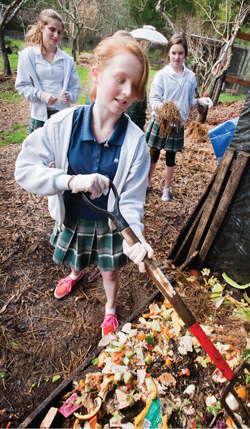Three years ago we reported on green efforts by Marin schools, highlighting Kentfield School District’s distinction as first in the nation to go solar and a handful of other schools that were moving away from wasteful, unhealthy lunch programs, toxic cleaners and pesticides. Today, sustainable lunch and recycling programs, energy conservation, awareness of chemicals and reducing carbon emissions are de rigueur in county schools. In fact, on that score, says Superintendent Mary Jane Burke, Marin schools are nationally ahead of the curve. “We have a community that believes and invests in our schools and public infrastructure,” she points out. Marin has taken the lead in the areas of innovative recycling, transportation congestion reduction, and now green business practices.
“Schools throughout Marin County are embracing green practices in how they operate their facilities and in supporting environmentally friendly activities for students, staff and families,” she says. Some of the newer measures include zero-waste lunch programs, organic gardens, water-reducing turf for athletic fields, green teen clubs and encouraging kids to carpool, walk or ride their bikes to school. The Mill Valley School District even has sustainability woven into its mission: “We prepare our students to be responsible, contributing members of our community and wise stewards of our natural environment.” The Bolinas-Stinson Union School District similarly pledges to be “a school that models sustainable practices, compassion and individual responsibility.”
Farther up 101, the Green Schools Coalition of Novato, which includes 13 public schools plus Novato Charter School, has adopted eco-friendlier practices ever since dealing with an indoor air quality issue back in 2001. Students now are not only eating farm-fresh food for lunch and following the reduce-reuse-recycle credo; they also breathe better air since schools stopped disinfecting with bleach and started using Green Seal Certified cleaning supplies. “One of the most important steps we’ve taken lately is school gardens,” adds district nutrition director Miguel Villarreal. “With the help of Novato Live Well, a parent organization, the district received nearly $40,000 in state grants that enabled us to create a food garden in every school.”
Private schools have likewise stepped up to the plate. While sustainability and stewardship might be expected of Waldorf-inspired programs like Greenwood in Mill Valley, more traditional institutions are thinking big as well. San Domenico in Sleepy Hollow, the state’s oldest independent school, earned another “-est” this year for having the largest school-based solar installation: 2,358 photovoltaic panels covering an area nearly the size of a football field. “While we are excited to be running electricity generated at our school,” says Head of School Mathew Heersche, “it is just one of the steps we’ve taken towards eco-responsibility.” Others include a WRAP-award-winning recycling program, energy-efficient gym lights and lunchtime composting.
Another green leader is Saint Marks School in Terra Linda, where science teacher Diane Bredt leads the charge. “We have made great progress in the last three years,” she says. “It all began with an audit by Lauralee Barbaria (Dean of the Green MBA program at Domincan University). Being able to quantify the energy, water (use) and waste enabled us to start the process and, most importantly, got administration and staff on board.”
A lighting audit prepared by the seventh graders (with Barbaria’s help) identified all the school’s lights by type and used a spreadsheet to determine how much energy might be saved by changing over to energy-efficient bulbs. Students presented their findings to the headmaster, facilities director and board and convinced them the switch was worth the investment. Cost to parents? Nothing, thanks to a grant from the Donner Foundation.
Plus, aided by a $15,000 community grant from Ghilotti Bros Contractors, the school literally turned a gray concrete play area green by making it a native butterfly habitat area. The school also hired Clean Air Lawn Care to care for the grounds. And this semester it committed to the goal of zero-trash lunches.
A no-trash policy has been in place for at least 10 years at Marin Horizon School in Mill Valley. “It’s been going just fine,” says school president Ros Hamar. “People take it as part of the routine.” Good Earth Natural Foods in Fairfax provides organic, locally produced meals; the students bring in their own dishes, which go home with them to wash. “One of our core values has always been the environment,” Hamar explains. “We teach (that) at every grade level: for instance, our first grade collects batteries to recycle, second and third graders raise fingerling salmon in incubators to release in nearby creeks, fourth and fifth (graders) participate in trail maintenance.”
Meanwhile, 10 Marin schools—most recently Walker Creek Ranch and Montessori de Terra Linda—have received Bay Area Green Business certification, and several more are working toward it, says Dana Armanino, green business coordinator for the county. “By getting the certification, the schools can demonstrate that not only have they taken the steps and committed to these green practices, but their efforts have been verified by an outside source.” To qualify, Montessori de Terra Linda had to satisfy a checklist of more than 100 requirements that included adding fluorescent lights and Energy Star equipment, reducing landfill waste, and conserving water via low-flow toilets and drought-tolerant plants.
All these changes aren’t only seen as planet-savers; they save money, too. “It’s not just about following a trend of being green,” says Superintendent Burke. “These efforts are about teaching our children responsible and sustainable habits for a lifetime.”

Mimi Towle has been the editor of Marin Magazine for over a decade. She lived with her family in Sycamore Park and Strawberry and thoroughly enjoyed raising two daughters in the mayhem of Marin’s youth sports; soccer, swim, volleyball, ballet, hip hop, gymnastics and many many hours spent at Miwok Stables. Her community involvements include volunteering at her daughter’s schools, coaching soccer and volleyball (glorified snack mom), being on the board of both Richardson Bay Audubon Center. Currently residing on a floating home in Sausalito, she enjoys all water activity, including learning how to steer a 6-person canoe for the Tamalpais Outrigger Canoe Club. Born and raised in Hawaii, her fondness for the islands has on occasion made its way into the pages of the magazine.


